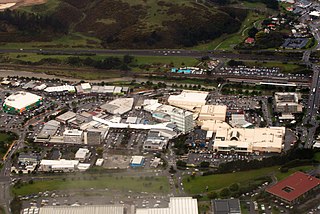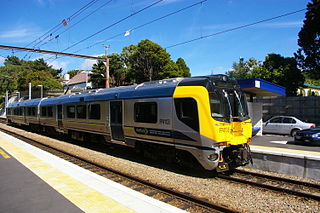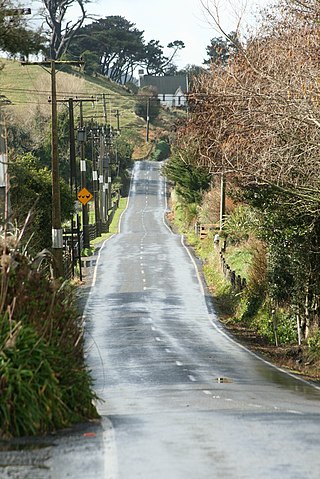
Porirua, a city in the Wellington Region of the North Island of New Zealand, is one of the four cities that constitute the Wellington metropolitan area. The name 'Porirua' is a corruption of 'Pari-rua', meaning "the tide sweeping up both reaches". It almost completely surrounds Porirua Harbour at the southern end of the Kāpiti Coast. As of June 2023, Porirua had a population of 60,900.

Wellington City Council is a territorial authority in New Zealand, governing the city of Wellington, the country's capital city and third-largest city by population, behind Auckland and Christchurch. It consists of the central historic town and certain additional areas within the Wellington metropolitan area, extending as far north as Linden and covering rural areas such as Mākara and Ohariu. The city adjoins Porirua in the north and Hutt City in the north-east. It is one of nine territorial authorities in the Wellington Region.

Tawa is the northernmost suburb within the Wellington city boundary, located roughly 15 km north of Wellington's CBD between Churton Park and Porirua in the North Island of New Zealand. It takes its name from the broadleaf tree, which was once prolific throughout the area, although its most famous tree is the Bucket Tree, a large macrocarpa with the topiary of an upside-down bucket. Tawa is also known for its large number of churches, representing a wide range of Christian denominations.

Khandallah is a suburb of Wellington, the capital city of New Zealand. It is located 4 kilometres (2.5 mi) northeast of the city centre, on hills overlooking Wellington Harbour.

Ngaio is an inner suburb of Wellington, the capital city of New Zealand. It is situated on the slopes of Mount Kaukau, 3500 metres north of the city's CBD. It was settled in the 1840s and many of its streets are named after early settler families. Ngaio was originally a logging community known first as Upper Kaiwarra, then as Crofton until 1908. The area was administratively part of a separate local authority called the Onslow Borough Council which amalgamated with Wellington City in 1919.

Newlands is one of the northern suburbs of Wellington, New Zealand. It lies approximately 8.1 km north of the city centre and to the east of its nearest neighbour Johnsonville. It has a long history of early settlement and originally was farmed including being the early source of Wellington's milk. Newlands is located in a valley and covers two ridgelines, the side of one of which overlooks Wellington Harbour and up to the Hutt Valley.

Churton Park is a suburb 1.5 km north of Johnsonville in Wellington, the capital city of New Zealand. It was established in the 1970s.
Ngauranga is a suburb of New Zealand's capital city, Wellington, in the lower North Island. Situated on the western bank of Wellington Harbour, it lies to the north of the centre of the city. The name comes from the Maori-language ngā ūranga, meaning "the landing place ". The Ngauranga Railway Station was known as "Ngahauranga" when it opened in 1874.

The Johnsonville Branch, also known as the Johnsonville Line, is a commuter branch line railway from the main Railway Station of Wellington, New Zealand to the northern suburb of Johnsonville via Ngaio and Khandallah.

Northland is a suburb in west-central Wellington, New Zealand. Not far from Victoria University it also includes low-priced accommodation popular with young students. It borders the suburbs of Highbury, Kelburn, Thorndon, Wilton, Wadestown and Karori. Northland is populated by a mix of university students, young professionals and families. Part of the area was known as Creswick until the late 19th century when new roads and building sites were developed by the landowner, C J Pharazyn, who marketed the whole area as Northland. At that time it was described in The Evening Post as "Wellington's best suburb".

Raroa railway station, one of eight stations on the Johnsonville Branch, serves the suburbs of Raroa and Broadmeadows. It is one of four stations on the line located on a curve.

Johnsonville railway station is the terminus of the Johnsonville Line, one of eight stations on the commuter branch railway north of Wellington in New Zealand’s North Island. It serves the suburb of Johnsonville, and as a bus interchange attracts traffic from other suburbs to the north and east.
Francis (Frank) Thomas Moore was a New Zealand political activist.

Crofton Downs is an inner suburb of Wellington, the capital city of New Zealand. It is situated between Ngaio to the northeast Wilton to the south-west and Wadestown to the south. Its border runs on the Korimako Stream that flows south into the Kaiwharawhara Stream and then flows down the Ngaio Gorge into Wellington Harbour.

Ohariu is a suburb of Wellington, New Zealand. It is a rural area, located 5 kilometres (3.1 mi) from Khandallah.
Paparangi, one of the northern suburbs of Wellington in New Zealand, lies approximately 10 km north of the city centre, north-east of Johnsonville, north-west of Newlands and south of Grenada and Woodridge. The population was 2,841 at the time of the 2013 census, an increase of 96 from the 2006 census population.
The Borough of Onslow was a local government district immediately to the north of Wellington, New Zealand. Incorporated on 13 March 1890 it included the districts of: Wadestown, Crofton, Khandallah and Kaiwarra but not Johnsonville. It replaced the Kaiwarra Town Board, the Wellington District Roads Board and a small part of the very wide jurisdiction of the Hutt County Council. Johnsonville Town Board remained independent.
The Old Porirua Road in the 19th century was the main road north up the west coast from Wellington to Porirua in New Zealand. It ran from Kaiwarra up the Ngaio Gorge to Ngaio, Khandallah, Johnsonville and Tawa to the Porirua Harbour. Most of the road still exists, although many sections are now local roads only, having been superseded as through roads.

Stuart Keith Spry was a New Zealand swimmer, conservationist and local politician. On his death The Dominion described him as "one of the great identities of Wellington city".
State Highway 59 (SH 59) is a New Zealand state highway in the Wellington Region linking Mackays Crossing to Linden. It came into existence on 7 December 2021, prior to the opening of the Transmission Gully Motorway and consists of the former route of State Highway 1 between Mackays Crossing and Linden.





















